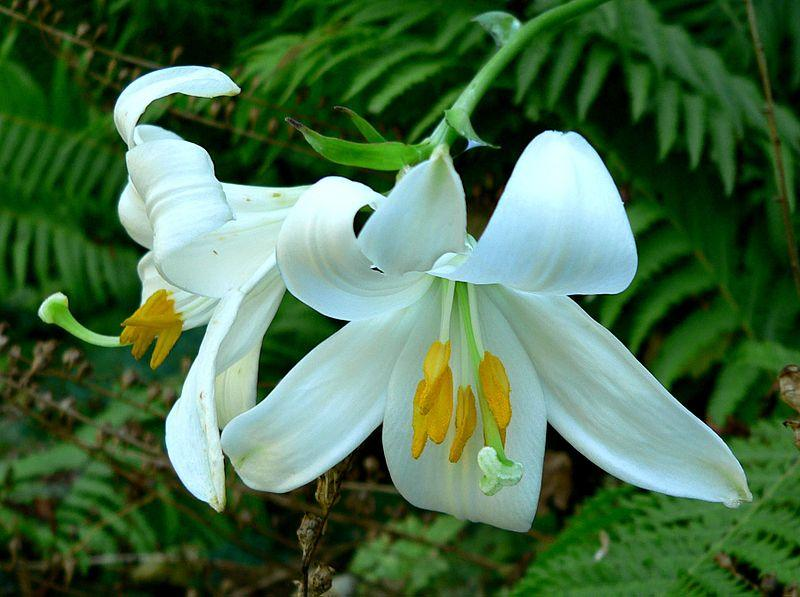
The condition of stamens being adjacent to sepals is
(A) Episepalous
(B )Epipetalous
(C) Epiphyllous
(D) Synantherous
Answer
565.8k+ views
Hint: Flower is a brightly coloured modified branch, which has four types of floral leaves-sepals, petals, stamens, and carpels. Each stamen is composed of filament(slender stalk) and anther(supporting knob-like structure) which contains microsporangia. There are different forms of androecium based on the condition of anther and filament(how they present)like polyandrous, epipetalous, epiphyllous etc.
Complete answer:
When the two-accessory whorl i.e., sepals and petals are not differentiated and leaves are alike in these or when only one whorl is present, in this case, it is called perianth. In perianth, each floral part is known as tepals. When the stamen is attached or adnate to petals is called epiphyllous. The following condition is observed in Lily.In the flower, each anther consists of two lobes, which is connected with the help of connective and it is described as dithecous. At times, the connective enlarged and the lobes get separated, this is described as divaricated or divergent anther lobes. Some or all of the stamens in a flower may be attached to petals or floral axis based on the species of plant. In some cases, some may be free-standing or some may be fused. In other cases, the filaments may be fused and anthers may be free, or the filaments fused and anthers may be free.

Hence the correct answer is OPTION(C)
Note: Some forms of androecium:
1.Polyandrous: Here, all the stamens are free in the androecium.
2.Epipetalous: Here, the filament of the stamens is attached with petals.
3.Episepalous: The stamens are attached with sepals.
4.Synandrous: When both the filaments and anthers are fused completely.
5.Gynandrous: Gynostemium is formed by uniting the anthers of stamens and the stigma of carpels.
Complete answer:
When the two-accessory whorl i.e., sepals and petals are not differentiated and leaves are alike in these or when only one whorl is present, in this case, it is called perianth. In perianth, each floral part is known as tepals. When the stamen is attached or adnate to petals is called epiphyllous. The following condition is observed in Lily.In the flower, each anther consists of two lobes, which is connected with the help of connective and it is described as dithecous. At times, the connective enlarged and the lobes get separated, this is described as divaricated or divergent anther lobes. Some or all of the stamens in a flower may be attached to petals or floral axis based on the species of plant. In some cases, some may be free-standing or some may be fused. In other cases, the filaments may be fused and anthers may be free, or the filaments fused and anthers may be free.

Hence the correct answer is OPTION(C)
Note: Some forms of androecium:
1.Polyandrous: Here, all the stamens are free in the androecium.
2.Epipetalous: Here, the filament of the stamens is attached with petals.
3.Episepalous: The stamens are attached with sepals.
4.Synandrous: When both the filaments and anthers are fused completely.
5.Gynandrous: Gynostemium is formed by uniting the anthers of stamens and the stigma of carpels.
Recently Updated Pages
The number of solutions in x in 02pi for which sqrt class 12 maths CBSE

Write any two methods of preparation of phenol Give class 12 chemistry CBSE

Differentiate between action potential and resting class 12 biology CBSE

Two plane mirrors arranged at right angles to each class 12 physics CBSE

Which of the following molecules is are chiral A I class 12 chemistry CBSE

Name different types of neurons and give one function class 12 biology CBSE

Trending doubts
One Metric ton is equal to kg A 10000 B 1000 C 100 class 11 physics CBSE

What is 1s 2s 2p 3s 3p class 11 chemistry CBSE

Discuss the various forms of bacteria class 11 biology CBSE

State the laws of reflection of light

Explain zero factorial class 11 maths CBSE

An example of chemosynthetic bacteria is A E coli B class 11 biology CBSE




